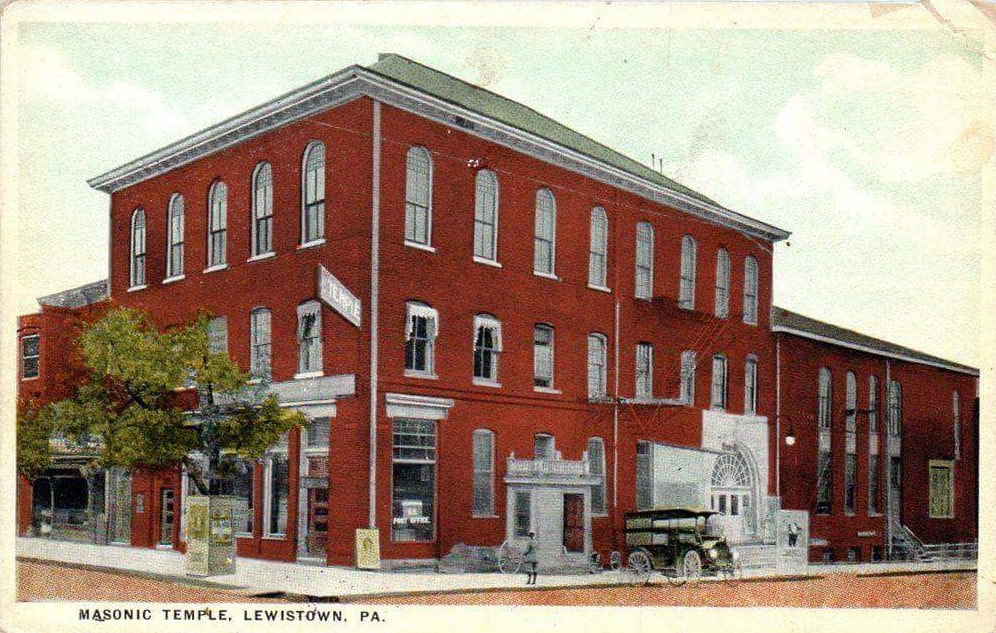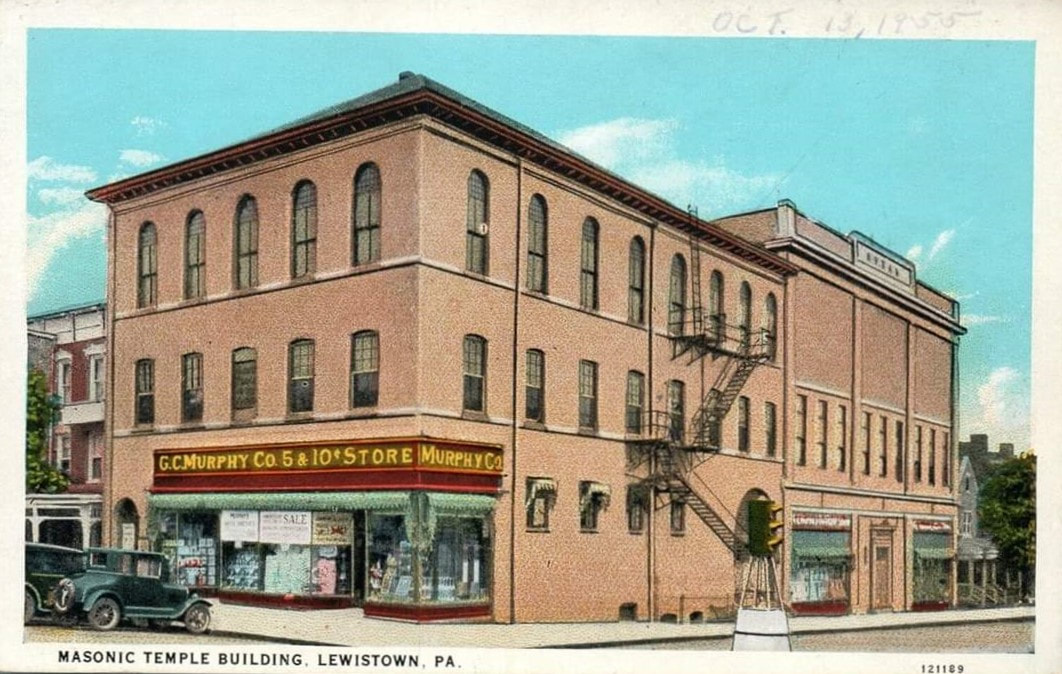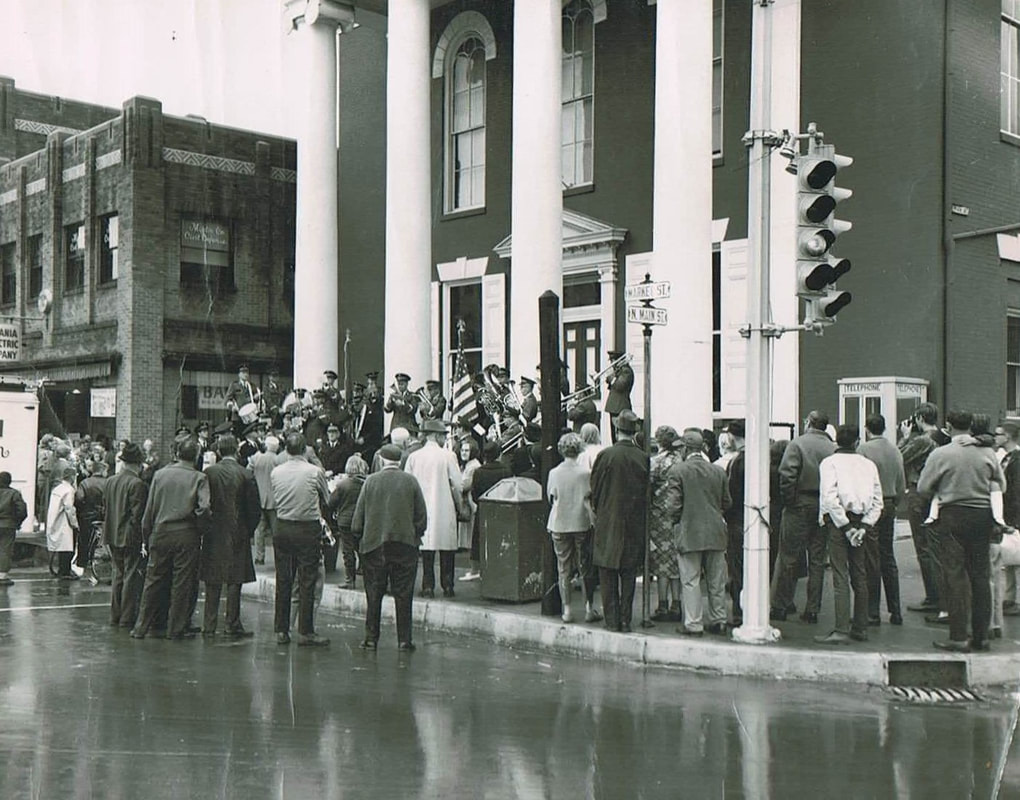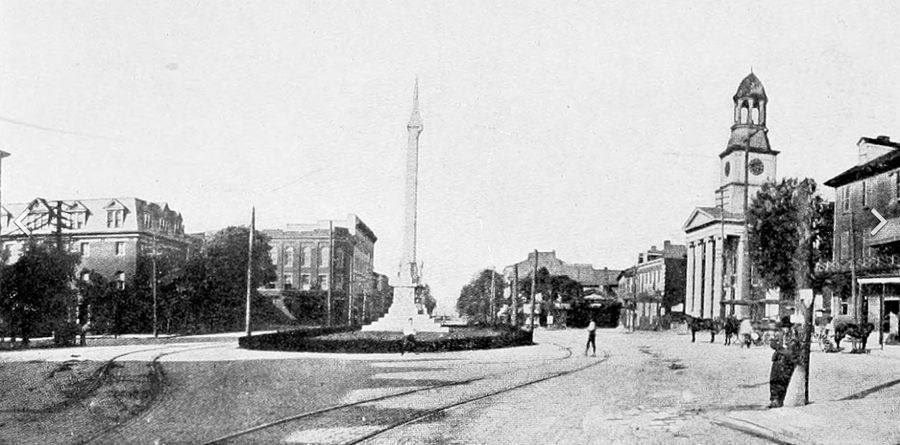|
Progress Lighting the Way for Commerce
The Montgomery Ward Building on Monument Square by Forest K. Fisher, Mifflin County Historic Society September 2013 One favorite local pastime was to leisurely stroll the main streets of Lewistown and window shop. Shoppers could walk the length of Market Street to see the seasonal displays at every business, from McMeen’s Department store to Wolf Furniture, plus so many more that are now just memories. One window to check out was on the Square at the Montgomery Ward store. Though the company is long gone from Lewistown, the business’ unique building, completed in 1929, is a reminder of commercial life over eighty years ago. The Montgomery Ward Building, prominently located at 3 West Market Street beside the historic Mifflin County Courthouse on the Square in Lewistown, is an impressive example of Art Deco style architecture. The building has been on the National Register of Historic Places since 1984, recognized for its unique architecture and its significance as an early member of Montgomery Wards’ chain of retail stores. Tens of thousands of area people shopped at Wards since the building’s construction over eighty years ago. The structure emerged from a fire in 1936, plus numerous remodeling, as well as the closing of the Wards store it was meant to house decades later. Utilized today for offices, the building also houses the Mifflin Juniata Arts Council Gallery, while the Mifflin County Train Club’s extensive model layout in the basement is a popular draw during of the annual Festival of Ice. The building is a fine, intact example of the restrained Art Deco style used by a number of chain stores in the 1920s and 1930s, according to the 1984 application for its inclusion on the National Register. The style was spreading into small town America at the time, suggesting a community’s sophistication, and presenting a modern, up-to-date appearance to visitors. Built in 1929 by mail order giant Montgomery Ward and Company, the building is also significant as one of Ward’s initial full-line department stores scattered across the United States in the company’s efforts against competitor Sears & Roebuck. "Progress Lighting the Way for Commerce", a torch-bearing female figure in diaphanous robes, was designed for the company by Scottish-American sculptor J. Massey Rhind. Her likeness often appeared in medallion form on many of Ward’s stores, including the Lewistown building. It is a feature high on the structure’s façade facing Monument Square, a diminutive rendering of the 22-foot colossal weathervane likeness placed atop the company’s Chicago headquarters at the turn of the 20th century. The Montgomery Ward Company, founded in 1872 by Aaron Montgomery Ward, is considered the world’s first mail order business, gaining its strongest supporters in rural areas through its illustrated catalog. Just three years later, Ward attracted more customers with the novel and unmatched advertising strategy of "satisfaction guaranteed or your money back". At its height, it was one of the largest retailers in the United States. In 1896 Wards acquired its first serious competition in the mail order business, when Richard W. Sears and Alvah C. Roebuck mailed their first general catalog. In 1900, Wards had total sales of $8.7 million, compared to $10 million for Sears & Roebuck. The two companies would struggle for dominance for much of the 20th century. In 1926, Wards broke with its mail-order-only tradition when it opened its first retail outlet. It continued to operate its catalog business while pursuing an aggressive campaign to build retail stores in the late 1920s. The company had 531 outlets, one being the Lewistown store, by 1929. In December 1928, the Lewistown Sentinel heralded Ward’s intention to establish a major store in Mifflin County. The newspaper headline read: SITE IS LEASED TO MONTGOMERY WARD; TO BUILD IN 1929. The property was owner A. Reed Hayes and at the time was occupied by a Weis Store and Lewistown Insurance and Realty Company. Hayes noted in the paper that the company would receive a five-year lease with the privilege of renewal. Wards planned a two-story structure above a 40 by 150 feet basement. Hayes expected to also demolish an adjoining brick building housing the Nickelette Lunch and Russ & Zampelli Shoe Repair, to make room for offices and a storeroom. The newspaper concluded the article by stating, “The announcement...brings to an end rumors and counter-rumors of the past six months concerning the establishment of a store here by the Montgomery Ward Company.” The location for the Lewistown store was carefully selected, according to company officials as reported in the local newspaper. Wards wasn’t expecting the town proper to sustain the new store, rather it was rural customers who were the real target. The practice of the period was to count foot traffic passing a prospective location to determine sales potential. Wards had a different plan. A company spokesman told the Sentinel, “...we...count the number of automobiles parked in the city on Saturdays or other popular trading days as indicative of the popularity of the city as a trading point for rural customers. We are coming here because we believe the people of the vicinity prefer to trade in Lewistown.” York, Pennsylvania architects C. Frank Witman and John B. Boyer attended the ground breaking for the Montgomery Ward Company, as did Lewistown attorney A. Reed Hayes. Building began in the Spring of 1929 by general contractor W. D. Steinbach and Sons who used all local craftsmen, according to news reports. The contractor’s site manager also was quoted as saying he, “...never had seen better materials and workmenship...than found here...” Some of the Art Deco architectural details include two-story bay windows and pilasters, bands of glazed terra cotta panels and a female figure holding a torch. This image was a standard Montgomery Ward logo known as the “Spirit of Progress.” An identical panel is located on the former Montgomery Ward building in Stroudsburg, PA. The original drawings for the Lewistown store indicate the panel was made by the Atlantic Terra Cotta Company expressly for Montgomery Ward. By the Fall, the store was ready for its grand opening. 18,000 announcements had been sent out in anticipation. The local store manager confidently asserted, “If we have the same experience we have had everywhere else, Lewistown will see the greatest influx of visitors during the next few months that it has ever known.” Sentinel headlines trumpeted the opening Saturday, October 26, 1929 - THOUSANDS AT STORE OPENING - Crowds Thronging Montgomery Ward & Company Store Today on Opening. Visitors entering from the front could walk to the back of the store and could go to departments in the basement or on the second floor. Directories of the goods on display were placed throughout the store. The mezzanine level offered attractive women’s clothing. The basement was filled with tires, hardware, bathroom fixtures and sporting goods. The newspaper noted, “Stoves played no small part of the basement displays.” Furniture, radios, and rugs were “ found galore in a pleasing arrangement on the second floor.” Female clerks were “attired nattily” in blue smocks with the letters “MW” on the sleeve. Just days later, November 1, 1929, the Penn Central Light and Power Company formally opened its new headquarters at 3 West Market Street, next door to Wards. It was identically styled, though not as tall. Four thousand roses were given out to the women visitors at Penn Central and the new display windows, also like those at Wards, made an excellent display area for the lamps, appliances and other merchandise sold by the company. Law offices were located above the power company and years later WMRF Radio would be located there, too. Early on the morning of December 21, 1936, a passerby smelled smoke emanating from the Wards Building. By 2:30 A.M. policeman Walter J. Tomlinson discovered smoke pouring from the basement ventilators and firemen were called. It took five hours and the injury of eleven fire fighters before the blaze was under control. To make the fire fighting even worst, ammunition from the sporting department exploded driving back the firemen. A hole was cut through from the Penn Central side to gain access and extinguish the blaze. 65 employees were thrown out of work, but Wards renovated and the store was placed back in business. Wards operated the department store on Monument Square until the 1970s, when it closed along with many of its other retail outlets across the country. America’s buying habits had changed and discount giants became the norm. The building, acquired by OK Properties of Lancaster, PA in the 1980s, was extensively renovated for offices. OK Properties also successfully applied for and secured the Montgomery Ward Building its National Register status in 1984. During the Mifflin County Bicentennial in 1989, street level offices in the building became headquarters for the Bicentennial Committee, its gift shop and the many activities involved with the yearlong celebration. Today, the 1929 Montgomery Ward Building is still a grand presence on the Square. The original storefront can be seen at street level beside the historic courthouse. The Mifflin Juniata Arts Council Gallery occupies the other side at street level. Arts Council president Angela Niman commented at the gallery’s opening in 2012, "The building of 3 West Monument Square is one of the original Montgomery Ward buildings constructed in 1929. When we were discussing what our first exhibit should be, our decision was inspired by the actual building, which includes a number of Art Deco characteristics." The grand old building’s architectural style is a reminder of our unique heritage, and a reflection of a quieter age, one of window shopping and department stores. Perhaps owner Mike Buffington best sums up the meaning of the Montgomery Ward building’s presence on Monument Square: “We are so fortunate to have such a unique art deco-era building in our community. It is very rare to find modern buildings that are constructed so well and contain the type of character found inside and outside of the Monument Square Center building. I encourage anyone to explore the building and discover all the beautiful craftsmanship that can be found. This building is still and will remain an asset to our community.” Special thanks to Mifflin County Historic Society Research Librarian Jean Laughlin. 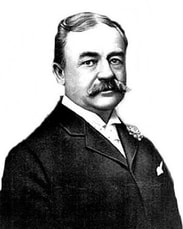 Aaron Montgomery Ward, founder of Montgomery Ward & Co. Aaron Montgomery Ward, founder of Montgomery Ward & Co.
Montgomery Ward & Co. Catalogs Brought Marketplace to American Farmsteads
Early retailer focused on rural residents by mailing Montgomery Ward catalogs, which offered thousands of items. July 2016 -- By George Wanamaker When Montgomery Ward & Co. put out its first mail order catalog in 1872, it was the first mail order catalog in the U.S. Aaron Montgomery Ward was a traveling salesman in northern Illinois. He found that rural customers often wanted “citified” goods, but when they found them at local, rural establishments, they were both more expensive and often of lower quality. Sensing a market, Ward launched a mail order business for dry goods. By eliminating the middleman, he created savings for his customers. Orders were shipped by rail to the nearest train depot. In late 1870 or early 1871, Ward – then based in Chicago – purchased a line of goods to sell, but his entire inventory was destroyed by the Great Chicago Fire in October 1871. Not to be deterred, he and two partners raised $1,600 and purchased new stock in 1872. In August 1872, they issued the first Montgomery Ward & Co. catalog, consisting of 163 items listed on one printed page. It was a difficult time in which to launch a new business. In the wake of a global economic depression (the Panic of 1873), Ward’s partners bailed out. And more than a few rural retailers, seeing him as unwelcome competition, destroyed his catalogs when possible. Revolutionary guarantee But Ward’s brother-in-law, George Robinson Thorne, saw an opportunity and joined him in the fledgling enterprise. Meeting rural residents’ need for affordably priced, quality dry goods, thecompany began to grow rapidly. Ward continued to expand his offering. In 1875, he staked his claim onquality, adding a guarantee of “satisfaction or your money back.” In 1883, the Montgomery Ward catalog – by then commonly referred to as “the wish book” – contained 10,000 items on 240 pages. Ward’s supplied necessities, but also offered many a farmer and his family items to dream about. The catalog helped reduce the isolation felt by many rural residents, and led to a less austere existence for those who lived far from the city. In 1893, the company began to face competition from an upstart. Sears, Roebuck & Co., also headquartered in Chicago, went head-to-head with Ward’s in a competition that would last more than a century. In 1900, Montgomery Ward did $8.7 million of business in mail orders alone (the company did not yet have a retail store). Competitor Sears, though, did $10 million business in mail order that year. Slow to recognize change In 1904, Ward’s mailed 3 million 4-pound catalogs to customers across the U.S. Four years later, the company built an enormous warehouse along the Chicago River, just north of downtown Chicago. Stretching nearly a quarter of a mile alongside the river, the warehouse contained 1.25 million square feet. By 1930, Ward’s had established distribution centers in Baltimore, Maryland; Ft. Worth, Texas; Kansas City, Missouri; St. Paul, Minnesota; Portland, Oregon; and Oakland, California. The company’s first retail outlet was opened in 1926 in Plymouth, Indiana. By 1928, Ward’s had opened 244 stores. That number more than doubled by 1930, when the company had 556 outlets. Despite losses in 1930, Ward’s became the country’s largest retailer by the end of the decade. The end of World War II signaled significant social change in the U.S., not the least of which was an enormous population shift to the suburbs. Ward’s was slow to recognize the change and began to lose its base. By the mid-1950s, a long, slow decline was underway. The storied company discontinued its mail order catalog in 1985 and closed its doors in 2001, 130 years after it started. More than 800 pages and 13,500 items In 1946, the Montgomery Ward & Co. catalog was named to a list of 100 books that had most influenced American life and culture. By then, the company was often referred to as “Monkey Ward,” a derivation of the early abbreviation “Mont’gy. Ward.” Interestingly, that nickname was used both by loyal customers and detractors. Thirty years after publication of the first Ward’s catalog, the book had swollen into a gargantuan tome. The 1912 catalog weighed in at 850 pages and contained some 13,500 items, including women’s clothing (nearly 10 percent of the catalog was devoted to that single category) as well as clothing for men and children, jewelry, kitchen items, guns, gas engines, paint, wallpaper, fabric, automotive items, a full-size auto garage (priced at $108), and, for the first time, an automobile, “The All Star.” Orders were shipped by rail to the depot nearest the customer. For the farm, there were windmills, pumps, tanks, plows, drills, planters, cultivators, discs, clod rollers, gristmills, corn shellers, hand tools and fencing. Parts were available for most implements and machines. Colored ink was used sparingly in the 1912 catalog, primarily for clothing, shoes, cloth, wallpaper and horse blankets. High-cost items were howcased in generous space. Small, inexpensive items such as kitchen utensils were packed in, as many as 60 items to a page. The 1912 Ward’s catalog offered just about anything a person could need, with the exception of food and housing. At some point, the company narrowed even that gap, offering house kits for sale. Even Rudolph came from Ward’s A child’s coloring book published by Montgomery Ward & Co. in 1939 propelled a hitherto unknown red-nosed reindeer named Rudolph to fame. Ironically, the charming holiday tale would long outlast the company that brought it to life. Working on assignment for Ward’s, author Robert L. May created the character in a poem for use in a coloring book. In its first year, 2.5 million copies were distributed. In 1949, May’s brother-in-law, Johnny Marks, adapted the poem into a song. Rudolph achieved immortality when singer Gene Autry recorded the song, which hit the No. 1 position on the Billboard pop singles chart during Christmas week 1949. Autry’s recording eventually sold 25 million copies; it remained the second best-selling record of all time into the 1980s. – George Wanamaker is a past president of the Mid-West Tool Collectors Association. He started collecting carpenter’s tools in the mid-1970s. Since then he’s also become a collector of farm and kitchen tools and anything old and unusual. Contact him at [email protected] |
Links to other local history: |
Content of this page is protected by copyright laws and may not be used without prior permission of Monument Square Center LLC. Website designed by www.onestop.biz












